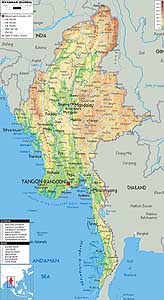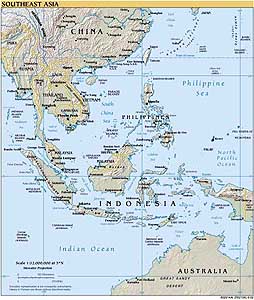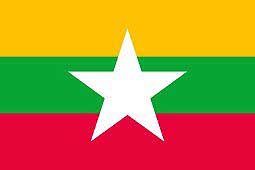-
- Myanmar Map
|
-
- Map
of Southeast Asia
|
|
-
|
- latest picture:
January 16, 2016
|
-
-
-
-
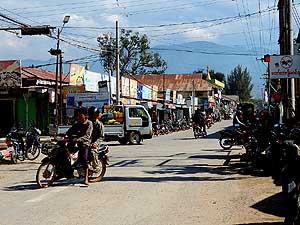
|
-
-
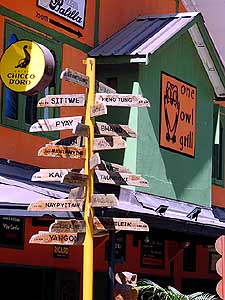
|
-
-
-
-
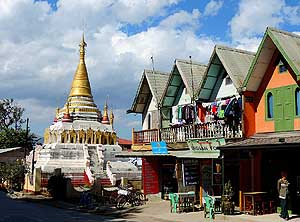
|
-
166
At the Northern edge of the 13½ miles
- [22km] long and 6¼ miles [10km] wide Inle
- Lake sits Nyaungshwe, a small relaxed little
- town, 7¾ miles [12½km] south of the railway
- station Shwenyaung, which is the base
- for the boat trips …..
|
-
167
….. despite its rather laid-back character,
- there is a sign also here showing the distances
- to different other Myanmar locations …..
|
-
168
….. side by side are the charming houses
- and the imposing Myazaydi Pagoda along
- ‘Yone Gyi’ Street
|
-
|
-
-
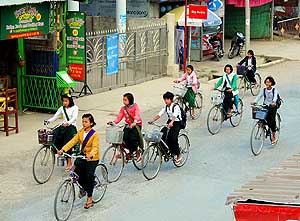
|
-
-
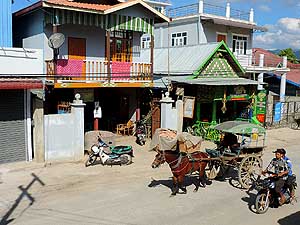
|
-
-
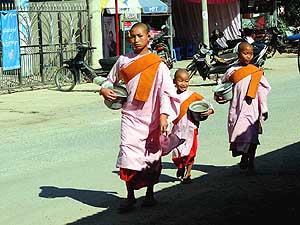
|
-
169 During the day the street life of
- Nyaungshwe is constantly changing: In
- the late afternoon children are cycling
- home from school …..
|
-
170 ..... in the morning horse-drawn
- carriages and motorbikes drive along
- the dusty road .….
|
-
171 ….. and at noon,
Buddhist nuns
- are walking along with their bowls and
- ask for alms from door to door
|
-
|
-
-
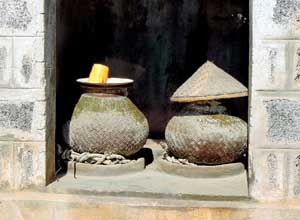
|
-
-
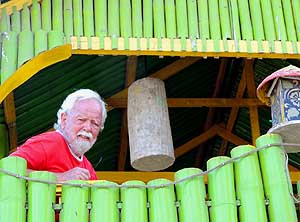
|
-
-
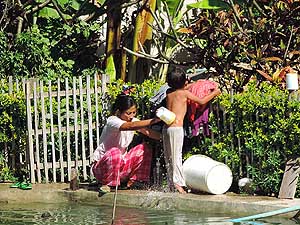
|
-
172 The two clay pots along the road
- are filled with cool drinking water – during
- the heat of the day a welcome refreshment
|
-
173 Emil at our favorite restaurant ‘Inle Palace’
- next to the ‘Golden Dream Hotel’ overlooking
- the main street ‘Yone Gyi’. Pizza, Spaghetti
- and other delicious Italian dishes keep us happy
|
-
174 Not everybody has
running water
- in their house in Nyaungshwe. A mother
- gives her boy a wash at a little pool
|
-
|
-
-
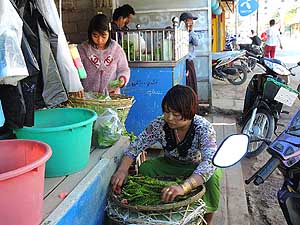
|
-
-
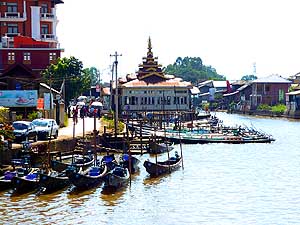
|
-
-
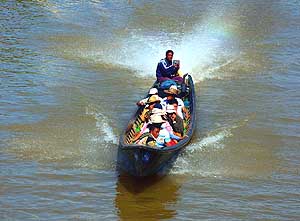
|
-
175 Sorting out vegetables is a common
- sight along the streets of Nyaungshwe
|
-
176 Waiting for tourists, moored boats
- are bobbing up and down gently at
- Nyaungshwe’s jetty
|
-
177 A speedboat approaches
Nyaungshwe’s
- jetty. Boat travels are part of daily life for
- people living in the stilt villages around Inle Lake
|
-
|
-
-
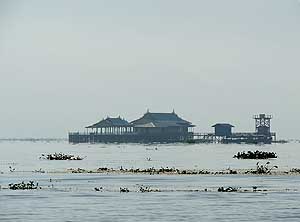
|
-
-
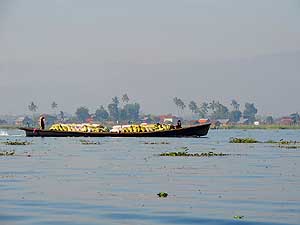
|
-
-
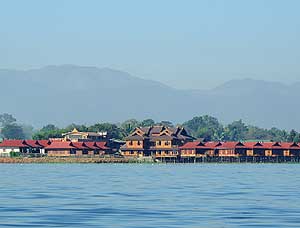
|
-
178 A peaceful mood on the shallow Inle
- Lake (45mi² [116km²], ø-depth 5 ft. [1½m]),
- the second largest freshwater lake in Myanmar
|
-
179 His cellular pressed against his ear,
- the boatman of the ‘Intha’ tribe (= sons
- of the lake) is sailing in his wooden cargo
- boat to the weekly market
|
-
180 The ‘Ann Heritage
Lodge’ on the
- western shore of Inle Lake is an upper class
- hotel – one of the (too) many around the
lake
|
-
|
-
-
-
-
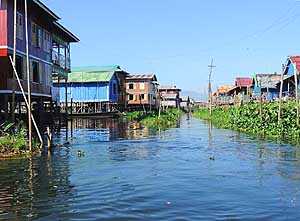
|
-
-
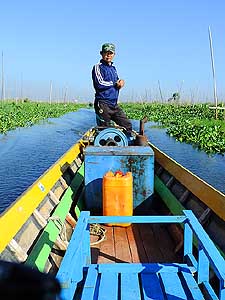
|
-
-
-
-
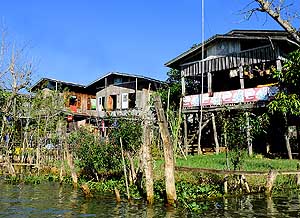
|
-
181
Inpawkhon is one of the 17 stilt
- villages at Inle Lake – the housing of
- predominantly people of the
- ‘Intha’ tribe
|
-
182
Our boatman guides us through a
- narrow canal where we are admiring the
- floating gardens. The long poles act as
- anchors (Fare: 5½ hours US$18 =2 people)
|
-
183
The life of the ‘Intha’ people living in the
- stilt villages, is concentrated totally on the lake
|
-
|
-
-
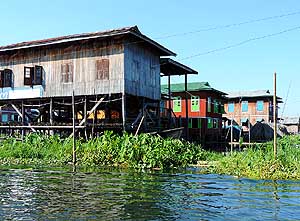
|
-
-
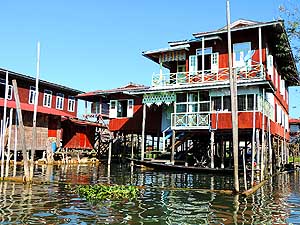
|
-
-
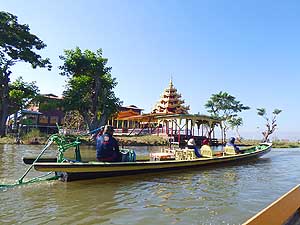
|
-
184 Approx. 70‘000 people
live on and
- around Inle Lake. Their income is generated
- mainly by growing vegetables on floating gardens
|
-
185 A lovely wooden two-storey stilt house
- along one of the many waterways in Inle Lake
|
-
186 A tourist boat is
moving slowly
- towards a golden stupa
|
-
|
-
-
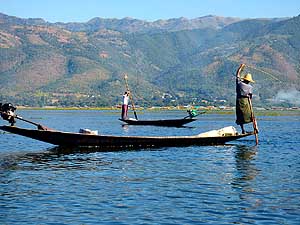
|
-
-
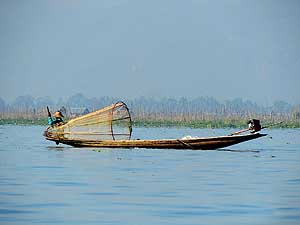
|
-
-
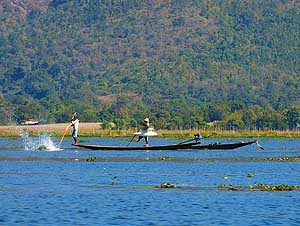
|
-
187 An art in itself: One of the fishermen is
- using the traditional technique of rowing the boat
- with one leg while using both hands for fishing
|
-
188 A fisherman is carrying his conical
- fyke net on the calm waters of Inle Lake
|
-
189 It looks like a
ballet, when
- the fisherman casts his throw net
|
-
|
-
-
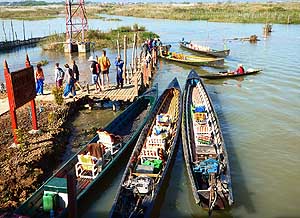
|
-
-
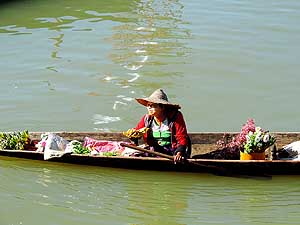
|
-
-
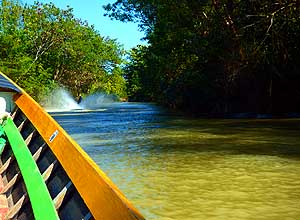
|
-
190 Mooring tourist longboats
- at a jetty of a souvenir factory
|
-
191 An Inle Lake resident is selling on
- her boat flowers and bananas to tourists
|
-
192 It is a joy speeding
through the narrow
- and windy river with its tree-lined shore from
- Inle Lake to the ‘Shwe Indein’-Pagoda
|
-
|
-
-
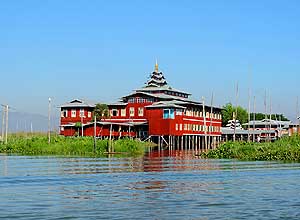
|
-
-
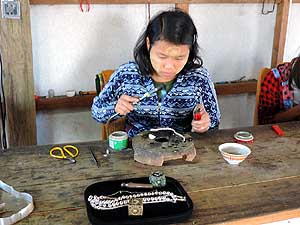
|
-
-
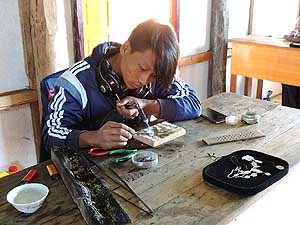
|
-
193 The huge multistory building, completely
- built on stilts, hosts the souvenir workshop
- ‘Ngwe Sin Tun’ and looks almost like a temple.
- There are a lot of those places, which are
- preferred targets by tourist boatsmen
|
-
194 The old tradition of craftsmanship is
- widely practiced at Inle Lake’s floating
- villages. At such a silversmith near
- Nampang we are able to watch the
- manufacturing of jewellery …..
|
-
195 ….. the traditional
handwork is
- not only carried out by females,
- but also by men
|
-
|
-
-
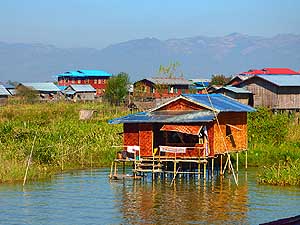
|
-
-
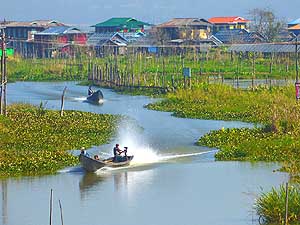
|
-
-
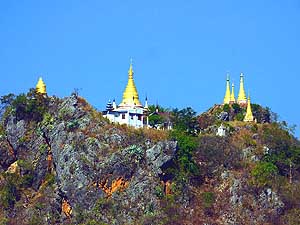
|
-
196 The ‘Intha’ tribe living in these stilt
- houses are fishermen and farmers …..
|
-
197 ….. they grow vegetables, fruits and
- flowers on the floating gardens. The gardens are
- a mix of marsh, soil and water hyacinths that are
- fixed with bamboo sticks on the lake’s ground
|
-
198 Very scenic: Golden
stupas
- northeast of Shwe Indein (Nyaung Ohak)
- greet from a hilltop
|
-
|
-
-
-
-
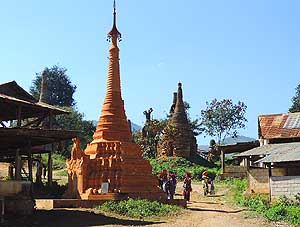
|
-
-

|
-
-
-
-
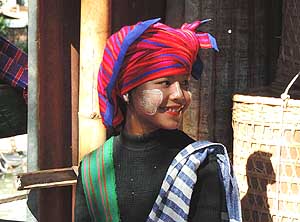
|
-
199
Young women of the village of Inthein
- (known also as Shwe Indein) are on the tourist
- catch at the ruins of Nyaung Ohak …..
|
-
200
….. they show off their “longyis“,
- the traditional sari, worn by men
- and women across Myanmar …..
|
-
201
…..one of the young girls with her
- decorative headdress smiles for a picture
|
-
|
-
-
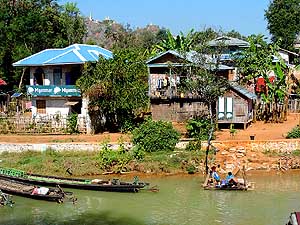
|
-
-
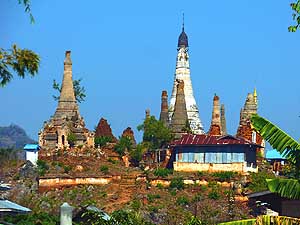
|
-
-
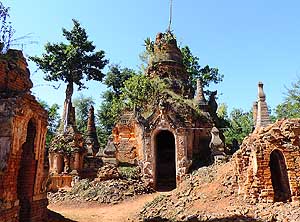
|
-
202 The dusty village of Inthein
|
-
203 The ruins of Inthein’s ‘Nyaung Ohak’
- (what means group of Banyan trees) spread
- a peculiar mood. They are reclaimed more
- and more by the jungle …..
|
-
204 ….. with their
crumpling and over-
- grown state they look quite picturesque
|
-
|
-
-
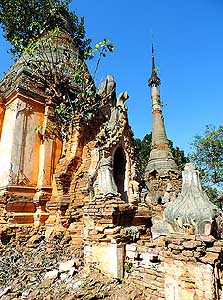
|
-
-
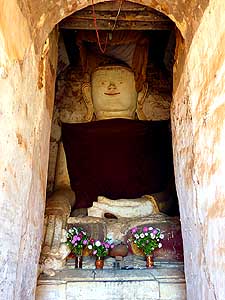
|
-
-
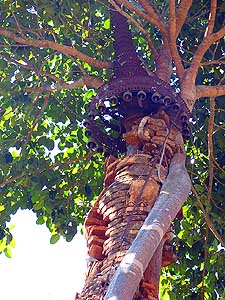
|
-
205
Despite its overgrown state, the
- stucco carvings at the ruins of ‘Nyaung
- Ohak’ in Inthein are still partly visible …..
|
-
206
….. also a faded Buddha statue
- carved into a rock shelter survived …..
|
-
207
….. a special proof of the power of
- nature is that the tree was able to lift even
- the “Hti“ (the umbrella of the stupa)
|
-
|
-
-
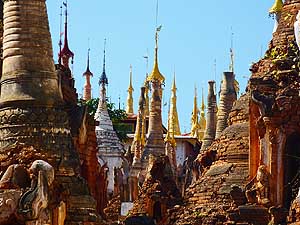
|
-
-
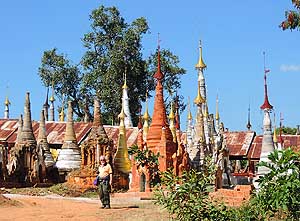
|
-
-
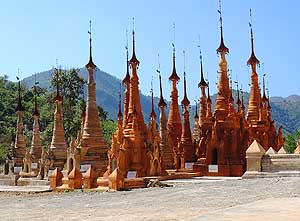
|
-
208
|
-
209
|
-
210
|
- At the Shwe Indein pagoda – located about 850 yards [<800m] on a hill
southwest of Inthein – tower 1’054 weather beaten
- ancient stupas of the 17th and 18th century, as well as
some recent golden ones. They are in all states of preservation
|
-
|
-
-
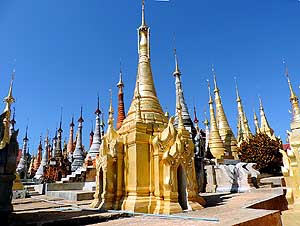
|
-
-
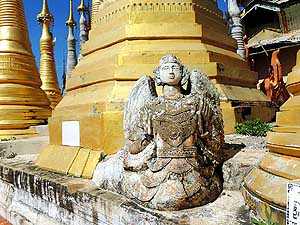
|
-
-
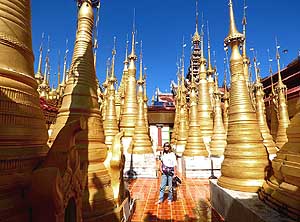
|
-
211 The golden (more recent?) stupas
- of the Shwe Indein pagoda are arranged
- around the central shrine
|
-
212 There is a richly ornamented ancient
- stone figurine on the plinth of a stupa at the
- Shwe Indein pagoda, which draws the attention
|
-
213 It is an overwhelming
feeling being
- surrounded by the golden stupas of the Shwe
- Indein pagoda. Liliana fully enjoys it
|
-
|
-
-
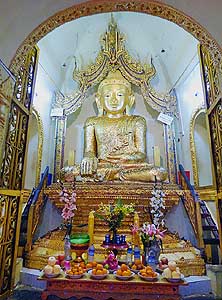
|
-
-
-
-
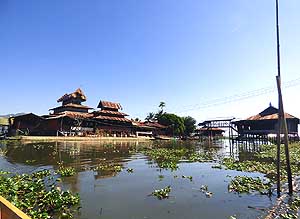
|
-
-
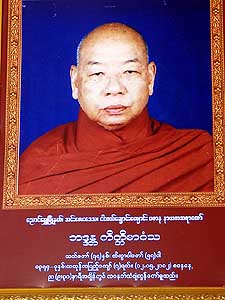
|
-
214
Buddha image at the shrine
- of the Shwe Indein pagoda
|
-
215
The teak wood monastery ‘Nga Phe
- Kyaung’ built on stilts is also called ‘The
- Monastery of the jumping cats’, because cats
- were trained by monks to jump through hoops.
- It lies 1.86 miles [3km] beeline NNE of Ywama
|
-
216
The portrait of a monk at the
- ‘Jumping Cat Monastery’ that is said
- to be the oldest and biggest
- Monastery in the Inle Lake area
|
-
|
-
-
-
-
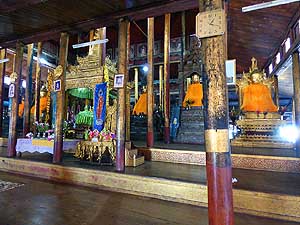
|
-
-
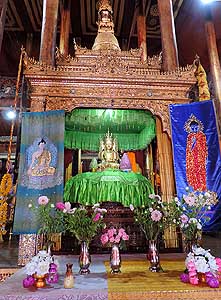
|
-
-
-
-
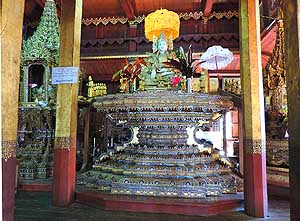
|
-
217
|
-
218
|
-
219
|
- Richly adorned antique Buddha images in the style of the Shan and
Bagan areas enrich the collection at the ‘Jumping Cat Monastery’
|
-
|
-
-
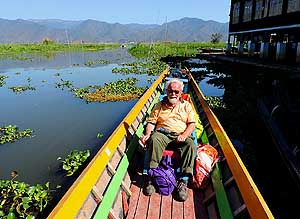
|
-
-
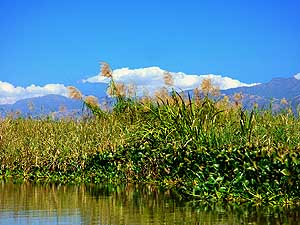
|
-
-
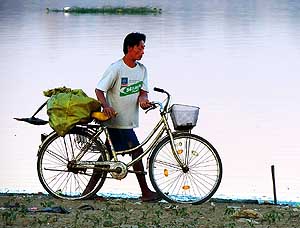
|
-
220 Everything fits! Emil makes himself
- comfortable on our boat. He is ready
- for the next ride
|
-
221 We glide through a canal that
- is engulfed by tall reed belts
|
-
222 A local walks his
bicycle along
- the seashore home to his village
|
-
|
-
-
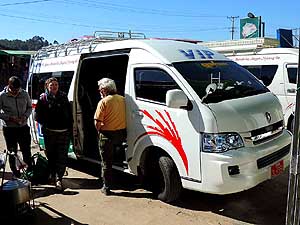
|
-
-
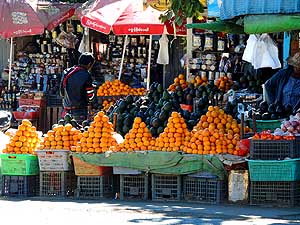
|
-
-
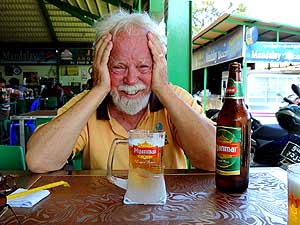
|
-
223 Emil is having a little chat with other
- passengers at the lunch stop with the minibus
- from Nyaungshwe at Inle Lake to Mandalay
- at the Irrawaddy River of Myanmar. The 106
- miles [170km] long drive took totally 8 hours
- and cost US$12.30 pp
|
-
224 The carefully piled up oranges
- into pyramids at a road stall
- are catching our eyes
|
-
225 It needs little to
make Emil look happy!
- At lunch time at ‘J & J BBQ & Beer
- Restaurant’ at 26th street in Mandalay
- (C. 21.98406°/96.06637°)
|
-
|
-
-
-
-
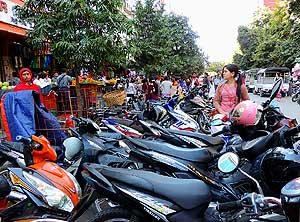
|
-
-
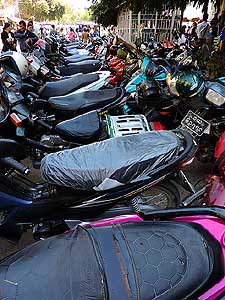
|
-
-
-
-
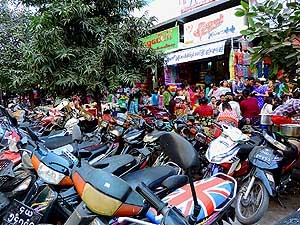
|
-
226
|
-
227
|
-
228
|
- A road in Mandalay, the second largest town of Myanmar with about
1.1m people on the east bank of the Irrawaddy River
- is crammed with parked motorbikes. Motorbike taxis are popular.
We also used them. It’s one of the means of transport –
- besides the helplessly overcrowded busses – that Burmese people
can also still afford
|
-
|
-
-
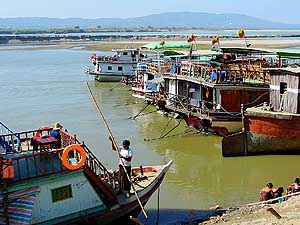
|
-
-
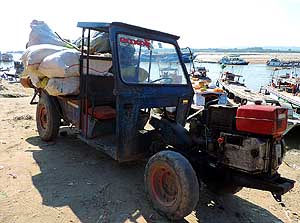
|
-
-
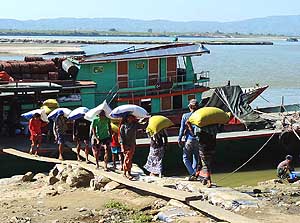
|
-
229 On the wide brown Irrawaddy River
- rather antique boats are moored. The river
- is a lifeline for the people, but nowadays
- also a tourist attraction
|
-
230 Also almost a museum piece?
- An archaic vehicle at the Irrawaddy
- River transporting goods
|
-
231 People are carrying
heavy bags on
- their heads to or from a ship. A scene from
- the Irrawaddy river bank in Mandalay
|
-
|
-
-
-
-
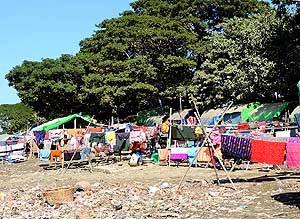
|
-
-
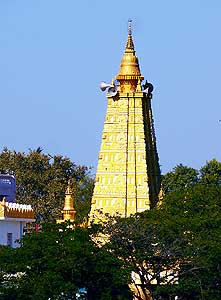
|
-
-
-
-
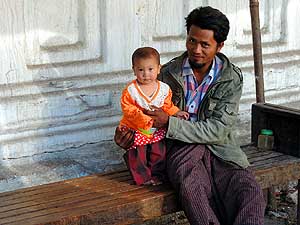
|
-
232
The many washing lines of the people
- living in very simple shacks and conditions
- along the Irrawaddy river bank make for
- a colorful picture
|
-
233
A foursquare pagoda along ‘Thinga
- Yazar Channel’ glows in the evening light
- of Mandalay. Mandalay is known to be the
- last capital of the Burmese Kingdom
|
-
234
A father is watching life on the streets
- of Mandalay with his cute little daughter
|
-
|
-
-
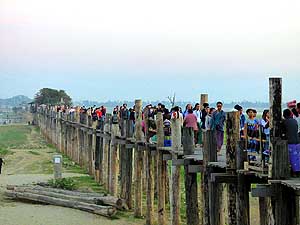
|
-
-
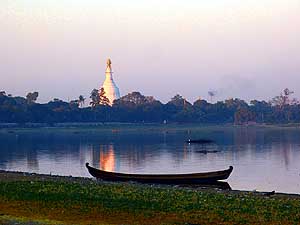
|
-
-
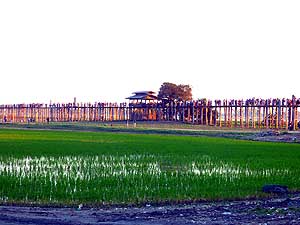
|
-
235 The pedestrial U Bein Bridge in
- Amarapura, about 7 miles [11km] south
- of Central Mandalay, is stretching 3'967 ft.
- [1'209m] across Lake Taungthaman. It is
- the world’s longest teak bridge …..
|
-
236 ….. the shallow Lake Taungthaman
- measures nearly 2 miles [3km]. In the
- background north of the lake glows the
- ‘Pahtodawgyi-Pagode’ in the evening
light …..
|
-
237 …..it offers a lovely
view to the bridge
- with its more than thousand posts, built in
- 1849. Some of the wooden pillars have
- been replaced by concrete poles
|
-
|
-
-
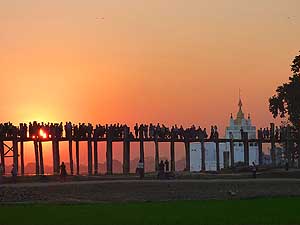
|
-
-
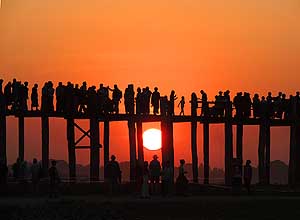
|
-
-
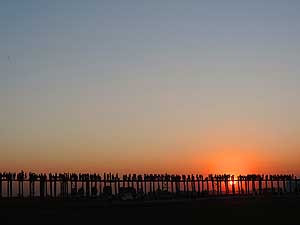
|
-
238
|
-
239
|
-
240
|
- An uninterrupted line of locals but also some tourists walk across
the U Bein bridge when the sun sets as a red ball on January 14th,
2017
|
-
|
-
-
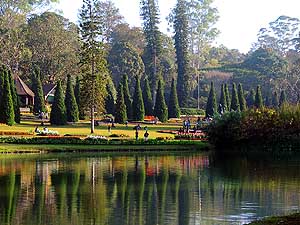
|
-
-
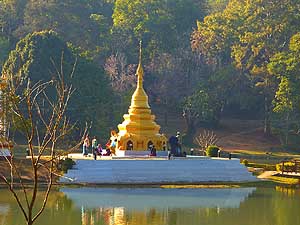
|
-
-
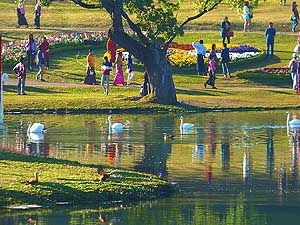
|
-
241 Perfect idyll at the lovely manicured
- ‘National Kandawgyi Garden’ in Pyin Oo
- Lwin (formerly Maymyo; 255’000 pop.) –
- a hill resort and popular recreational park at
- 3’538 ft., 42 miles [67km] east of Mandalay
|
-
242 A lovely little golden pagoda shines
- on a small island in the Kandawgyi Lake
|
-
243 The Kandawgyi Lake is
home to
- white swans and ducks. The lovely and
- peaceful former botanical garden has
- become a popular picnic spot for
- locals and an attraction for tourists
|
-
|
-
-
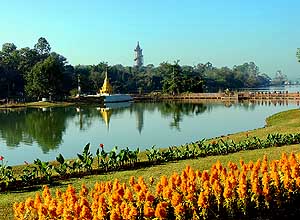
|
-
-
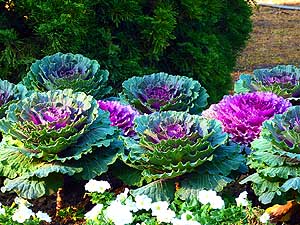
|
-
-
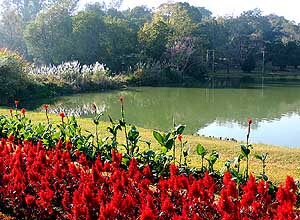
|
-
244
|
-
245
|
-
246
|
- The beautifully arranged flowerbeds around the peaceful lake at
the ‘National Kandawgyi Garden’ in Pyin Oo Lwin,
- fascinate in their variety of flowers and their vibrancy of colors
|
-
|
-
-
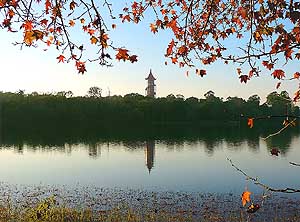
|
-
-
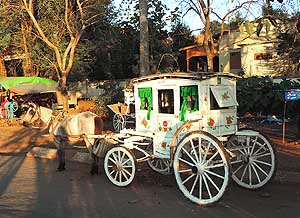
|
-
-
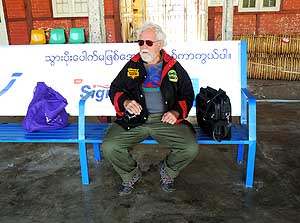
|
-
247 The 12-storey Nan Myint Tower in
- the ‘National Kandawgyi Garden’ is reflecting
- in the calm water. Unfortunately its viewing
- deck is currently closed for visitors
|
-
248 Nostalgic horse-drawn carriages are still
- a popular and attractive mean of transport in
- Pyin Oo Lwin, the summer residence of the
- former British colonial government. Burma –
- today Myanmar – belonged to British India
|
-
249 Emil is waiting on a
bench at the railway
- station of Pyin Oo Lwin for the delayed train
- direction Lashio. We intend to drive during
- 5½ hours over the Goitek viaduct until
- Kyaukme – fare US$1.75 pp
|
-
|
-
-
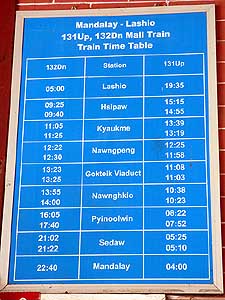
|
-
-
-
-
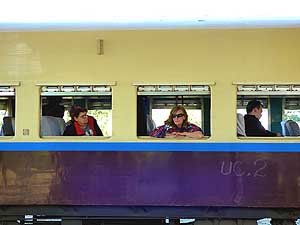
|
-
-
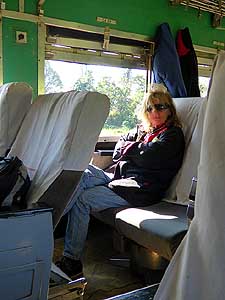
|
-
250
The time table board at the
- Pyin Oo Lwin train station to Mandalay,
- Kyaukme and Lashio
|
-
251
Liliana is looking out of the train window.
- Our „Upper Class“ wagon of train „№ 131up“
- is solely occupied by tourists. All have the
- same goal: The 335 ft. [102m] high famous
- ‘Goteik’ trestle viaduct
|
-
252
Liliana is making herself comfortable
- in the train to Kyaukme, 65 miles [105km]
- northeast of Pyin Oo Lwin
|
-
|
-
-
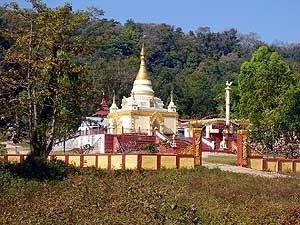
|
-
-
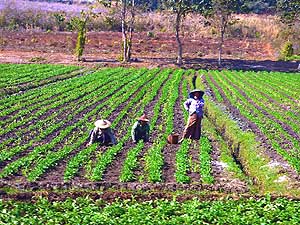
|
-
-
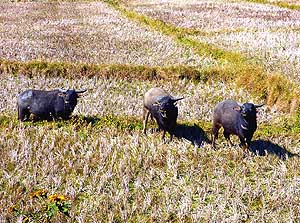
|
- The scenery rolling past is diverse – pagodas and all kinds of
agriculture
|
-
253 An impressing Buddhist temple
- in the countryside
|
-
254 Women are tilling their fields, wearing
- broad-rimmed straw hats to protect them
- from the scorching sun
|
-
255 Buffalos are roaming
on harvested fields
|
-
|
-
-
-
-
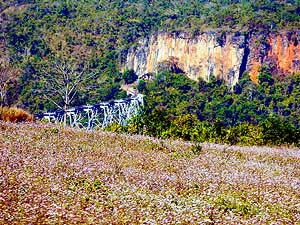
|
-
-
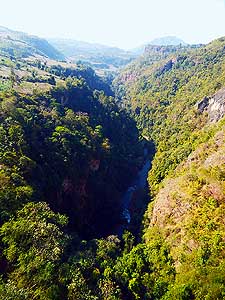
|
-
-
-
-
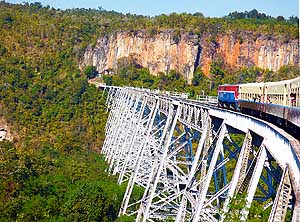
|
-
256
The train slows down and descends
- to the main attraction, the 335 ft. [102m] high
- and 2‘260 ft. [689m] long trestle viaduct
- of Goteik in Nawnghkio. It was built by
- American engineers, commissioned by the
- British colonial government in 1901 …..
|
-
257
….. view into the dizzying
- depth of the Goteik Gorge …..
|
-
258
….. and the most exciting moment
- when the diesel train „crawls“ in walking
- speed over the trestle viaduct without any
- rails. Will the old steel construction from
- 1901 also continue to hold for us?
|
-
|
-
-
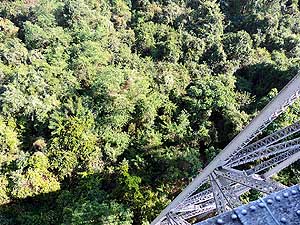
|
-
-
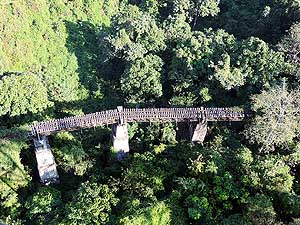
|
-
-
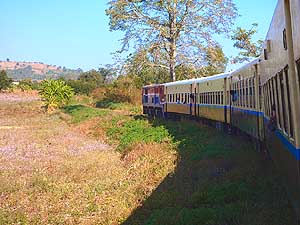
|
-
259 The view downwards
- catches the subtropical treetops
|
-
260 Towards the bottom of the gorge
- we spot other rails: Due to strategic reasons
- a diversionary route deeper downwards
- was built 1976, in case the main bridge was
- sabotaged. It was decommissioned in 2002
|
-
261 The highlight – the
Goteik viaduct – is
- over. We continue our journey for another two
- hours past a landscape dotted with flowers until
- Kyaukme, from where we return by share taxi
- the next day to Mandalay: Fare pp US$12.35
- /110 miles [177km]/4 hours
|
-
|
-
More websites from Myanmar:
- Myanmar (Burma) Part
1 –
from Yangon (Rangoon) to the 'Golden Rock' of
Kyaiktiyo
- Myanmar (Burma) Part
2 –
Bago (Pegu) - Shwenyaung at Inle Lake
- Myanmar (Burma) Part 4 – from
Mandalay to Bagan by ship and back to Yangon (Rangoon)
|
- The African trip
2013-16:
- CapeVerde: Santiago/Praia
part 1 – November18th to December 13th, 2013
- CapeVerde: Fogo
– Dezember13th to 23rd, 2013
- CapeVerde: Brava
– December 23rd to 26th, 2013
- Cape Verde: Santiago/Praia
part 2 – December 26th, 2013 to February 28th, 2014
- Cape Verde: São Nicolau – February
28th to March 13th, 2014
- Cape Verde: São Vicente/Mindelo part 1
– March 13th to 20th, 2014
- Cape
Verde: Santo Antão/Eastern side part 1 –
March 20th to April 7th, 2014
- Cape
Verde: Santo Antão/Western side part 2 –
April 7th to 10th, 2014
- Cape
Verde: São Vicente/Mindelo part 2 –
April 10th to 29th, 2014
-
Namibia Part 1 –
from Walvis Bay to Windhoek
- Angola Part 1
–
September 26th to October 4th, 2014
- Angola Part 2 –
October 4th to 22nd, 2014
-
Namibia Part 2 –
from Windhoek to the Angolan border, back again and on to
South Africa
-
South Africa
Part 1 –
from Namibia border to Capetown –
January 22nd to February 23rd, 2015
- 3rd Major Repair of our
LandCruiser FJ60 - 1982 (due to two broken sideshafts)
-
South Africa Part 2 – from Capetown to Tsitsikamma National Park –
February 24th to March 13th, 2015
- South Africa Part 3 – from
Addo National Park to the Lesotho border – March
13th to April 7th, 2015
-
Lesotho – April 7th to 15th, 2015
-
South Africa Part 4
– from the Lesotho to the Swaziland border –
April 15th to 23rd, 2015
-
Swaziland – April 23rd to 28th,
2015
-
South Africa Part 5
– from the Swaziland to the Botswana border
– April 28th to May 15th, 2015
-
Botswana
-
Zimbabwe
-
Mozambique
-
Malawi
-
Armed Robbery in Malawi on July
31st/August 1st, 2015
-
Tanzania
-
Kenya
-
Ethiopia Part 1 – from Kenya to
Djibouti –
October 25th to November 18th, 2015
-
Djibouti –
October 18th to 27th, 2015
-
Ethiopia Part 2 –
from
Djibouti to
Sudan –
November 27th to December 9th, 2015
- Sudan –
December 9th, 2015 to January 8th, 2016
|
![]()
